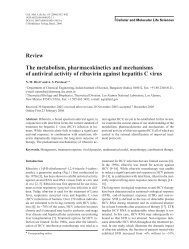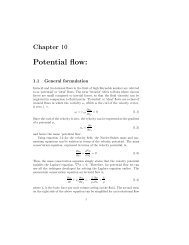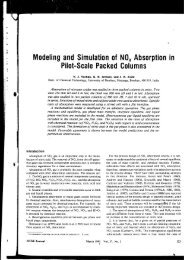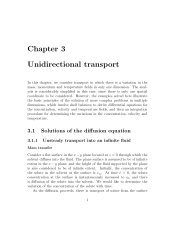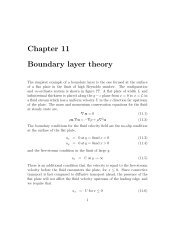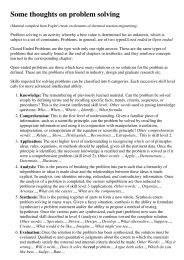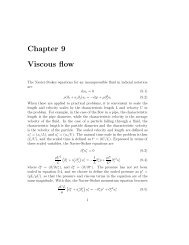Chapter 5 Steady and unsteady diffusion
Chapter 5 Steady and unsteady diffusion
Chapter 5 Steady and unsteady diffusion
You also want an ePaper? Increase the reach of your titles
YUMPU automatically turns print PDFs into web optimized ePapers that Google loves.
16 CHAPTER 5. STEADY AND UNSTEADY DIFFUSION<br />
condition is called the Neumann Greens function G N ,<br />
G N (x =<br />
1<br />
4πK|x − x s | + 1<br />
4πK|x − x I |<br />
(5.56)<br />
A similar procedure could be used for more complicated geometries. The<br />
Greens function for a source in a corner with zero flux conditions, as shown in<br />
figure 5.7(a), could be obtained by using four sources of equal strength placed<br />
symmetrically in an infinite domain. Similarly, the Greens function for a<br />
source in a corner with zero temperature conditions, as shown in figure 5.7(b),<br />
could be obtained by placing two sources <strong>and</strong> two sinks symmetrically in an<br />
infinite domain. The Greens function for a source in a finite channel, as<br />
shown in figure 5.8, would require an infinite number of sources.<br />
5.2.5 Greens function for a sphere<br />
The Dirichlet Greens function G D for a sphere is the solution for the temperature<br />
field due to a source of unit strength which satisfies the zero temperature<br />
condition at the surface of the sphere. This Greens function can be derived<br />
using spherical coordinates (r, θ, φ). Consider a source of strength 1, which<br />
is located, without loss of generality, at x S = (0, 0, r) in a sphere of radius<br />
1, as shown in figure 5.9. The image, by symmetry has to be located along<br />
the line joining the source point <strong>and</strong> the origin, at x I = (0, 0, r ′ ), but the<br />
strength Q I can, in general, be different from that of the source. The temperature<br />
at a point on the surface, x = (r, θ, φ) in spherical coordinates,<br />
or x = (sin (θ)cos (φ), sin (θ) sin (φ), cos (θ)), due to the source <strong>and</strong> sink, is<br />
given by<br />
T =<br />
=<br />
=<br />
1<br />
4πK|x − x I | + Q<br />
4πK|x − x I |<br />
(<br />
1<br />
1<br />
4πK (sin (θ) 2 cos (φ) 2 + sin (θ) 2 sin (φ) 2 + (cos (θ) − r) 2 1/2<br />
)<br />
Q<br />
+<br />
(sin (θ) 2 cos (φ) 2 + sin (θ) 2 sin (φ) 2 + (cos (θ) − r ′ ) 2 ) 1/2<br />
1<br />
4πK<br />
(<br />
1<br />
(1 + r 2 − 2r cos (θ)) 1/2 + Q<br />
(1 + r ′2 + 2r ′ cos (θ)) 1/2 )<br />
(5.57)<br />
The values of Q <strong>and</strong> r ′ are determined from the boundary condition on the<br />
surface of the sphere, which requires that T = 0 for all values of θ <strong>and</strong> φ.




